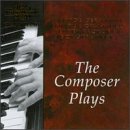| All Artists: Enrique Granados, Sergey Prokofiev, Igor Stravinsky, George Gershwin Title: Gershwin, Granados, Prokofiev, Stravinsky: The Composer Plays Members Wishing: 0 Total Copies: 0 Label: Nimbus Records Release Date: 11/18/1997 Genres: Dance & Electronic, Classical Styles: Opera & Classical Vocal, Ballets & Dances, Dances, Chamber Music, Forms & Genres, Concertos, Short Forms, Sonatas, Historical Periods, Classical (c.1770-1830), Modern, 20th, & 21st Century Number of Discs: 1 SwapaCD Credits: 1 UPC: 710357881329 |
Search - Enrique Granados, Sergey Prokofiev, Igor Stravinsky :: Gershwin, Granados, Prokofiev, Stravinsky: The Composer Plays
 | Enrique Granados, Sergey Prokofiev, Igor Stravinsky Gershwin, Granados, Prokofiev, Stravinsky: The Composer Plays Genres: Dance & Electronic, Classical
|
Larger Image |
CD Details |
CD ReviewsA note on the reproducing piano... Larkenfield | 01/09/2006 (5 out of 5 stars) "These pianos were considered state-of-the-art wonders at the time, from around the turn of the century until the Depression hit in the late 1920s and the general public could no longer afford them. In the meantime, many famous pianists performed on these engineering marvels and listeners would be unable to distinguish between an actual live performance or the performance of the reproducing piano itself. Alfred Cortot used to promote them by starting out with a live performance behind a veiled curtain and then having the reproducing piano take over without the audience being able to tell the difference. That's how good they were. Further, Artur Rubinstein, Paderewski, Rachmaninoff, Horowitz, Gershwin, Granger, Granados (the great Spanish composer who died in 1916 after his ship was sunk by a German sub), Prokofiev, Stravinsky, Edwin Fisher and many of the other piano giants of their day all thought well enough of these instruments to have lucrative contracts with these piano companies, and the sonic reproduction of these instruments - when properly regulated - was phenomenal, capturing their interpreters' performance amazingly well for posterity. I have at least 10 of these CDs by either Klavier Records (who started their company by reproducing these piano rolls) or by Nimbus Records, which has a rich catalogue of these reproduced performances. There is no discernible loss of shading of nuance in these performances, and there is a special joy to hear these great pianists of a bygone era at their peak of their creativity and genius without the scratchy and tinny sound of the primitive phonographs of the day. I share this information so listeners will seek out these reproduced performance as far superior to the scratchy 78s many of these same performers made during the same period. By doing so, they'll understand just how moving and satisfying some of these early piano legends were, such as Paderewski, who was born in 1860. Well, not on this particular record, but on others, the listener can hear an authentic Paderewski performance in digital sound (!) That's what happens when two technologies of a bygone and the modern era are teamed up - wonderful. Paderewski would have to be 120 years old to have made it into the digital age (1980) without these amazing reproducing pianos having preserved his legacy beforehand. These instruments were truly wonders - and still are. This particular performance of Granados by Granados is even better than the tremendous performances of his works by Alicia de Larrocha. He was a phenomenally subtle, passionate and sensitive pianist, and it's all captured in this amazing recording." Machine versus human A piano teacher | Reading, PA United States | 02/21/2006 (3 out of 5 stars) "These are competent, realistic transfers from a controversial technology. Piano-roll manufacture is well documented, but almost never detailed in modern liner notes. Usually it is said the rolls "capture" a pianist's dynamics. What is not said is that these measured dynamics all had to be transferred manually to issued rolls by an editor, who strove against the limitations of the commercial mechanism. (For example, Edgar Fairchild encoded Rachmaninoff's dynamics.) The keyboard lay in sections, within which no two keys could play at different intensities at once. Some notes were shifted to allow the mechanism to assign specific volume levels, which caused rhythmic anomalies at times. Pedal perforations were strictly on-off -- half pedaling had to be simulated by fluttering, or lengthening of specific notes. Rolls have been transferred to LP many times over the years, and one good way to assess them is to listen to multiple transfers of the same roll. That they differ so much from each other is proof enough that their best use is for enjoyment, rather than documenting a pianist's work." Revealing reproductions Walter K. Heuler | Dana Point, CA | 02/26/2005 (4 out of 5 stars) "This disk recreates performance recorded by the composers using the Aeolian Duo-Art recording system. Similar to a player-piano, but substantially more complex, the Duo-Art was able to capture not just notes and timing but tone and attack, so that when played back it recreated most if not all of the original performance. How much of the composers' performance is lost is difficult to say, as there are few recordings to compare to, however I found the performances intriguing and convincing. Gershwin's performance of the solo piano version of Rhapsody in Blue from 1925 is idiosyncratic and delightful. The sound quality is far better than that of a recording from that time period. These performance do not sound mechanical to my ear. There may be some limitations to the Duo-Art technology, but those limitations do not prevent me from enjoying these revealing performances."
|

 Track Listings (20) - Disc #1
Track Listings (20) - Disc #1